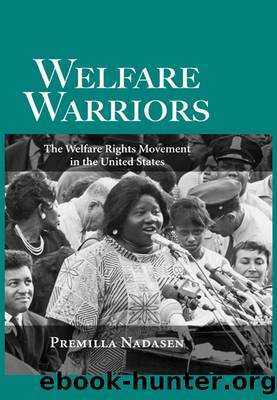Welfare Warriors by Nadasen Premilla;

Author:Nadasen, Premilla;
Language: eng
Format: epub
ISBN: 668723
Publisher: Taylor and Francis
CHAPTER 6
The Guaranteed Annual Income and FAP
The most ubiquitous slogan of the welfare rights movement was “welfare is a right.” T-shirts, banners, buttons, and posters were emblazoned with that short but provocative phrase. Welfare activists believed, as New York City welfare recipient Jennette Washington succinctly stated, that they “have a right to [welfare] because the Constitution says that everyone has a right to life. Life includes everything necessary to maintain life.”1 In the 1960s, welfare organizers sought to make the right to welfare available to everyone. The movement’s early campaigns to bring AFDC under constitutional protection and raise the standard of living for welfare recipients contributed to this goal. The right to welfare, however, was most clearly embodied in the movement’s demand for a guaranteed annual income, which would make economic status the only criteria for eligibility and sever the historic link between employment and income. Since the 1966 founding convention, a guaranteed income had been NWRO’s long-term goal, but little had been done to explicitly plan or organize for it.
By 1969, NWRO made the guaranteed annual income its main strategy. In that year, the organization entered the national political debate about income maintenance when Richard Nixon proposed his own version of a guaranteed income, the Family Assistance Plan (FAP). The differences between Nixon’s and NWRO’s plan notwithstanding, the organization seized the moment to influence the direction of legislative reform and implement its dormant long-term goal. Welfare organizers demanded that the federal government replace the current welfare system with a guaranteed minimum income, which would bring all people who fell below that, working or not, up to a decent standard of living. They believed that the guaranteed annual income ought to be a targeted grant, with money going to the poor to lift them above the poverty line, rather than a universal grant given to everyone, regardless of income. This demand was in many ways a culmination of many of the earlier struggles of welfare recipients. A guaranteed minimum income for all poor people, regardless of sex, family status, personal behavior, or employment status, promised to eliminate casework and standardize and simplify the administration of welfare. Raising the living standard of all poor Americans to an adequate level could also ameliorate racial and economic inequality. In addition, divorcing wages from work challenged age-old American traditions, which tied economic well-being to employment.
Although men and women in NWRO had a different rationale for wanting a guaranteed income—the male staff emphasizing the lack of employment opportunities and the female constituency framing the guaranteed income as necessary because of their work as mothers—they united around this goal. The struggle for a guaranteed income revealed the organization’s principal strength and prime weakness as a political movement. Nationwide debate about the merits of a guaranteed income enabled NWRO to push its agenda, bringing it to the zenith of its influence. Nixon introduced FAP in part because of NWRO’s agitation and political pressure, which contributed to the momentum to reform the welfare system. In addition, NWRO leaders
Download
This site does not store any files on its server. We only index and link to content provided by other sites. Please contact the content providers to delete copyright contents if any and email us, we'll remove relevant links or contents immediately.
The Secret History by Donna Tartt(16618)
The Social Justice Warrior Handbook by Lisa De Pasquale(11489)
Thirteen Reasons Why by Jay Asher(7786)
This Is How You Lose Her by Junot Diaz(5764)
Weapons of Math Destruction by Cathy O'Neil(5034)
Zero to One by Peter Thiel(4823)
The Myth of the Strong Leader by Archie Brown(4789)
Promise Me, Dad by Joe Biden(4444)
Stone's Rules by Roger Stone(4415)
Beartown by Fredrik Backman(4412)
How Democracies Die by Steven Levitsky & Daniel Ziblatt(4396)
The Fire Next Time by James Baldwin(4340)
100 Deadly Skills by Clint Emerson(4075)
A Higher Loyalty: Truth, Lies, and Leadership by James Comey(4031)
Rise and Kill First by Ronen Bergman(4012)
The David Icke Guide to the Global Conspiracy (and how to end it) by David Icke(3880)
The Farm by Tom Rob Smith(3871)
Secrecy World by Jake Bernstein(3782)
The Doomsday Machine by Daniel Ellsberg(3730)
